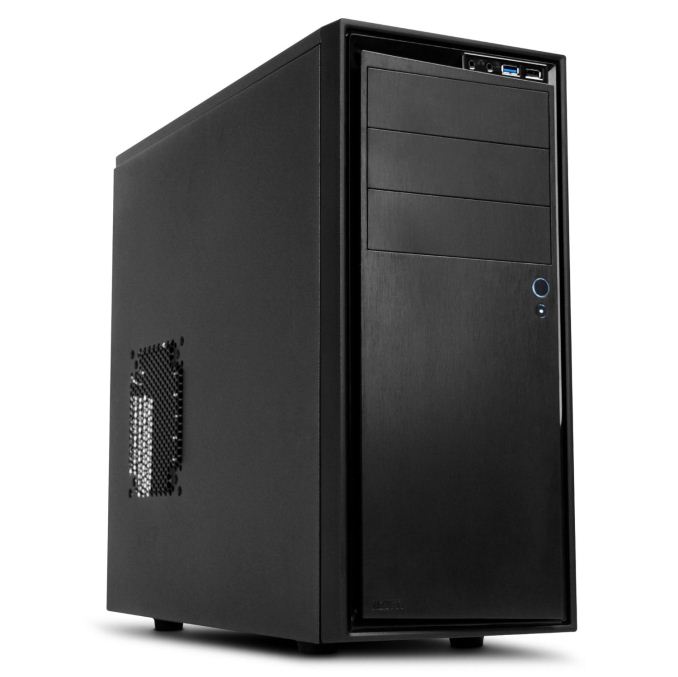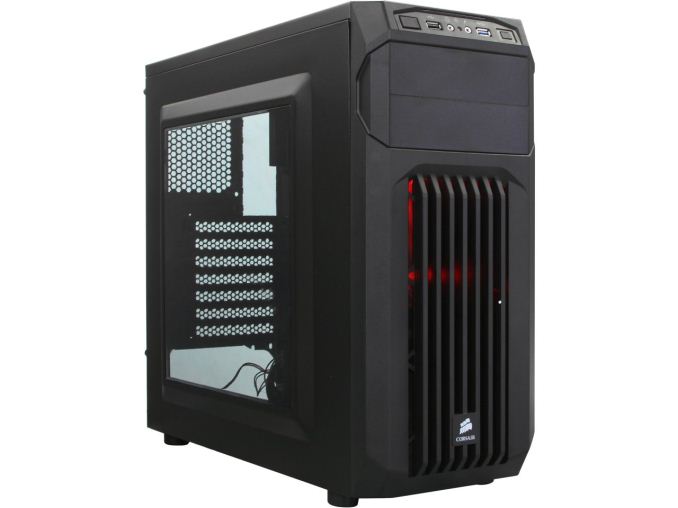Best PC You Can Build for Under $500
by Jarred Walton on August 1, 2014 11:11 AM EST
With yesterday's launch of AMD's 65W Kaveri APUs, it seemed a good time to give some recommendations for new system builds. We're starting out at the budget end of the spectrum, however, and pricing/availability on Kaveri generally rules it out. We'll keep things short and look at two builds, one AMD and one Intel. Outside of the CPU/APU and motherboard, parts are generally interchangeable.
| Budget AMD System | ||
| Component | Description | Price |
| CPU | AMD A6-6400K (2x3.9GHz, 1MB, 65W, 32nm) | $65 |
| Motherboard | MSI A88X-G41 | $73 |
| RAM | Team Vulcan 8GB (2x4GB) DDR3-2133 CL10 | $71 |
| Storage | Seagate Barracuda ST1000DM003 1TB | $55 |
| SSD | SanDisk Ultra Plus SDSSDHP-128G-G25 128GB | $60 |
| Case | NZXT Source 210 S210-001 | $40 |
| Power Supply | Seasonic SS-300ET 300W 80 Plus Bronze | $38 |
| Total (without OS) | $402 | |
The Kaveri APUs provide a decent blend of general and gaming performance, but finding one priced reasonably for a budget system is still a bit difficult (depending on your definition of budget, of course). While the idea of an inexpensive system capable of running games is fine, the cost to go from the A6-6400K we've selected to one of the Kaveri A10 models is more than the cost of a moderate dedicated graphics card like the R7 250, and the A6-7400K and A8-7600 are hard to find – and when you can find them, they're priced $15 higher than the MSRP. If you can wait a bit, the A6-7400K and A8-7600 should become more readily available. In the meantime, the A6-6400K will provide similar performance with a slightly slower graphics configuration.
 For the rest of the system, the MSI motherboard can support both existing Richland APUs like the A6-6400K we've selected as well as Kaveri APUs. Similarly, the DDR3-2133 RAM can provide better bandwidth than DDR3-1600 RAM that would only save you a buck. For storage, you've got three options: go pure SSD and have fast storage performance but without a lot of capacity, buy the 1TB HDD and sacrifice performance for capacity, or get both. Personally, I'd go with a pure SSD or the SSD+HDD configuration.
For the rest of the system, the MSI motherboard can support both existing Richland APUs like the A6-6400K we've selected as well as Kaveri APUs. Similarly, the DDR3-2133 RAM can provide better bandwidth than DDR3-1600 RAM that would only save you a buck. For storage, you've got three options: go pure SSD and have fast storage performance but without a lot of capacity, buy the 1TB HDD and sacrifice performance for capacity, or get both. Personally, I'd go with a pure SSD or the SSD+HDD configuration.
Wrapping things up, the case is a decent looking and not too expensive NZXT Source 210. Cases can be a very subjective topic, and there are plenty of reasonable options, but the NZXT is a good choice for a budget build. You could also drop down to a micro-ATX case and motherboard, and if that's what you're after the MSI A78M-E45 would be a good alternative. For the power supply, the small increase in efficiency offered by 80 Plus Gold isn't really worth the added cost at this price, and Seasonic makes a good 300W unit that will provide good efficiency for a low-power system like this while still allowing for the use of a moderate discrete GPU down the road should you choose to upgrade.
| Budget Intel System | ||
| Component | Description | Price |
| CPU | Celeron G1850 (2x2.9GHz, 2MB, 53W, 22nm) | $50 |
| Motherboard | Gigabyte GA-H97M-D3H | $80 |
| RAM | Team Vulcan 8GB (2x4GB) DDR3-1600 CL9 | $70 |
| Storage | Seagate Barracuda ST1000DM003 1TB | $55 |
| SSD | SanDisk Ultra Plus SDSSDHP-128G-G25 128GB | $60 |
| Case | Corsair Carbide Series SPEC-01 | $50 |
| Power Supply | Seasonic SS-300ET 300W 80 Plus Bronze | $38 |
| Total (without OS) | $403 | |
The Intel budget build is going to provide a pretty similar experience to the AMD build overall; single-threaded performance will be a bit higher, but graphics performance will be lower. The price for these two builds is equivalent at around $400 – which includes both a 128GB SSD and a 1TB HDD, so you can shave off $50 by dropping one or the other storage option. The Celeron G1850 is Intel's least expensive Haswell option right now, and while budget CPUs aren't going to win in any performance contests, for normal tasks they're still plenty fast. Paired with a 128GB SSD they can make for a decent home/office system and the price is certainly appealing. Overclocking isn't really a goal of either of these builds, and Gigabyte's GA-H97M-D3H should do fine for stock clocks.
 The one other noteworthy change is that we've included a slightly more expensive (and perhaps a bit too gaudy for some) Corsair Carbide SPEC-01 case. It has lots of angles and vents, and while Corsair has made some very good cases opinions on aesthetics are still up for debate. It ships with two 120mm fans for cooling, which is going to be overkill for a budget build like this but will give you room to grow. It also has a case window and red LED lighting for those that want to show off a bit.
The one other noteworthy change is that we've included a slightly more expensive (and perhaps a bit too gaudy for some) Corsair Carbide SPEC-01 case. It has lots of angles and vents, and while Corsair has made some very good cases opinions on aesthetics are still up for debate. It ships with two 120mm fans for cooling, which is going to be overkill for a budget build like this but will give you room to grow. It also has a case window and red LED lighting for those that want to show off a bit.
Of course we're still missing the OS, keyboard, mouse, and display; these are all commodity items and most people have existing accessories they can carry over from an old PC. Unless you're running a free OS like Ubuntu or some other flavor of Linux, the cost of Windows is going to represent a significant increase in price of nearly $100, putting us at the $500 mark referenced in the title. Adding a 20" to 22" LCD will tack on another $100-$140, and a keyboard and mouse will be $25 combined for a basic set. So all told if you want a complete new PC the price will be closer to $650, but $500 for the core system and software is a good starting point. You can also find some mail-in rebates on quite a few parts that might drop the price a bit, but as those change regularly I haven't included any in the above tables.










85 Comments
View All Comments
andrewaggb - Friday, August 1, 2014 - link
What's the use case?A dirt cheap gaming build could skip the ssd, get less expensive motherboards and cases, and get a better processor/gpu.
An office pc may not need the hard disk (ssd only) and probably could have a much smaller case.
A cheap nas pc wouldn't need the SSD but would want multiple WD Red's (or similiar) and a case with good drive cooling and accessibility.
An HTPC would be quiet, small, low power, and depending where the media files are stored, would either want way more storage or could just use the ssd or a small disk. Might need good wifi.
It just seems to me you can buy a basic 'all around' pc cheaper, from dell or asus or hp, including windows. If you're on a tight budget and have a specific need, then you cater to that need as I outlined above.
I generally like your articles, I'm hoping this can be seen as constructive feedback.
Daniel Egger - Friday, August 1, 2014 - link
I agree. I just bought an Inspiron 2 weeks ago from Dell, with G3220, 1 TB HDD, Win 8, Mouse + Keyboard, WLAN + BT and DVD Burner for $309 which is even more budget and has more features and a Windows license. Heck, I could even take the difference, add the SSD and a discrete GPU and end up with a much better system with warranty, OS and less hassle at the same price.DanNeely - Friday, August 1, 2014 - link
At this price point an oem box is almost always a better buy for general computing use (IIRC Arstechnica's cheapest build guides explicitly note this); but there're always people who'd rather build anyway. Build vs buy for office/web/gaming PC generally doesn't swing strongly in favor of build in cost terms until you get upward of $1k because you've moved far enough up the feature scale that you're moving into configurations with upgrades that are marked up significantly to cover the R&D/marketing/etc costs that race to the bottom boxes have no margin to fund.Beany2013 - Sunday, August 3, 2014 - link
Working in the retail space, I can confirm that there is no margin in building anything other than serious, serious workstations - and we're talking dual CPU stuff here in chassis that can handle a dozen drives for video production at 4k here, rather than just something with an i7 in it.Even gaming builds are contentious thanks to warranty claims being a PITA, unless you exclusively do nothing but that class of build and so can afford to swap the part out with existing stock (As you'll have a dozen GTX 760s floating around - most retail shops don't) and worry about getting the stock back later.
That said, even though I can get these OEM systems cheap (as I say, I work in retail and know the margins ;-) ) I still build my own. There is a certain satisfaction in having a machine that's near silent at full load because you put a *proper* air cooler on it, etc.
Evil_Sheep - Saturday, August 2, 2014 - link
"What's the use case?"This is the main question on my mind too. Let's be honest, if you]re reading Anandtech you're almost surely in the market for something more powerful. And if you're building a PC for basic usage, as others have pointed out, you'd almost surely obtain better value from an OEM. Like you're spending $100 on a Windows license which is 20% of the budget, whereas you can't compete with the OEM's who are buying bulk MS licenses at discount. Not to mention the warranty which would surely be useful for the basic user.
The real question is who is in the market for this kind of basic desktop these days? The concept is almost as obsolete as floppy drives. For a lot of basic users, these days frankly I'd just point them to an iPad.
Bobsy - Friday, August 1, 2014 - link
Great article, thank you. I have many friends and relatives in need of a cheap PC upgrade and your suggestions come at the right time.hojnikb - Friday, August 1, 2014 - link
If they have specific budget and needs (gaming, office, editing) you can get a far better build if you look around reddit.com/r/buildapcthis build really don't make much sense to be honest
gicetifaf - Friday, August 1, 2014 - link
Huh. The Intel build doesn't make much sense. Why 8GB? You'll be bottlenecked like heck with that CPU, and the total amount of RAM is going to be your last concern using the Celeron.I'd change the Celeron for a Pentium G3258 along with a H81M-P33 ($45). You get a more powerful CPU which is overclockable, a microITX (always a plus) motherboard and the MB itself is half the price of the one you've got there... while making for a more sensible build overall.
Also why get a costlier case for the Intel? Is that just to make the Intel build cost as much as the AMD?
I love AnandTech (been a lurker for years), but these builds don't make much sense, really.
hojnikb - Friday, August 1, 2014 - link
Sadly, you'll have a bad time overclocking with that mobo.gicetifaf - Friday, August 1, 2014 - link
That's true, you won't reach the CPU's max potential, but you can still squeeze a bit of free performance out of your CPU and the mobo is cheap as dirt, which I guess is the point of the entire article here?